Kyoobin Lee
GraspClutter6D: A Large-scale Real-world Dataset for Robust Perception and Grasping in Cluttered Scenes
Apr 09, 2025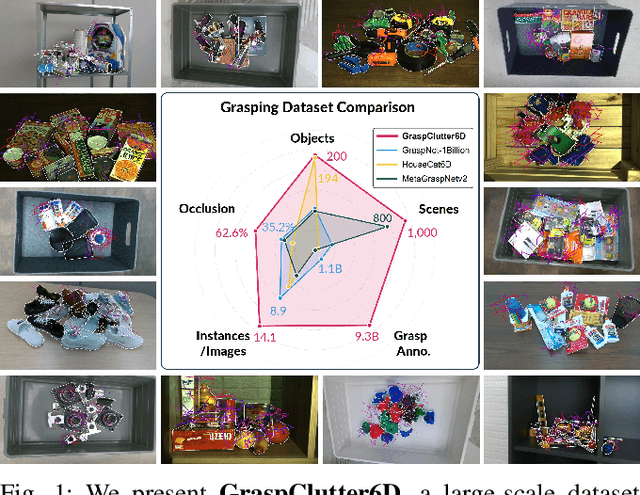
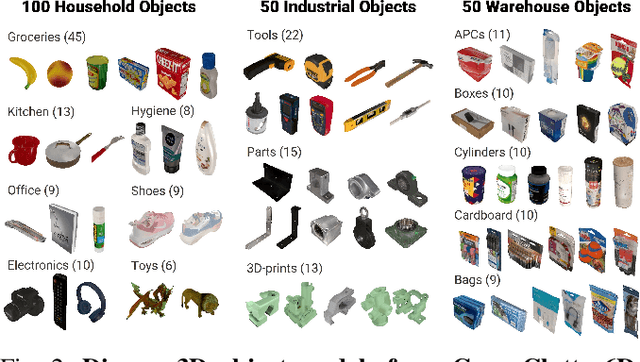
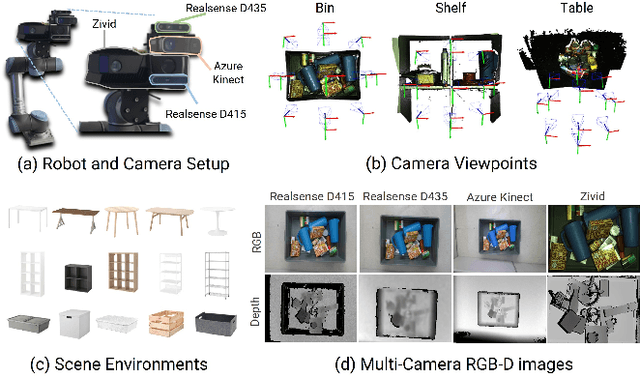
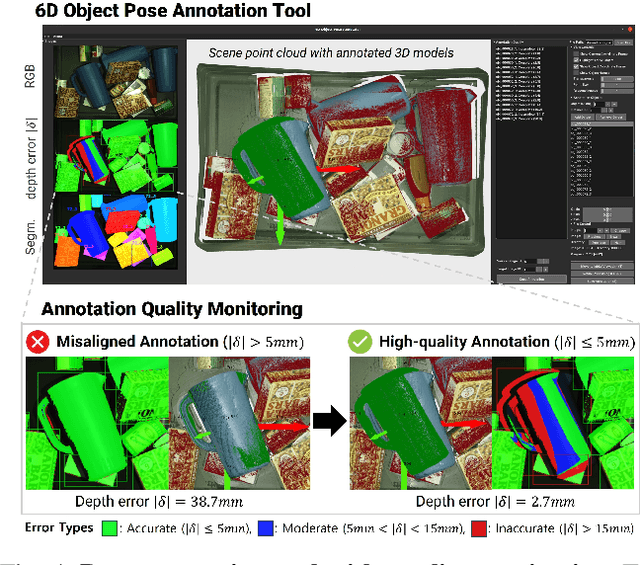
Abstract:Robust grasping in cluttered environments remains an open challenge in robotics. While benchmark datasets have significantly advanced deep learning methods, they mainly focus on simplistic scenes with light occlusion and insufficient diversity, limiting their applicability to practical scenarios. We present GraspClutter6D, a large-scale real-world grasping dataset featuring: (1) 1,000 highly cluttered scenes with dense arrangements (14.1 objects/scene, 62.6\% occlusion), (2) comprehensive coverage across 200 objects in 75 environment configurations (bins, shelves, and tables) captured using four RGB-D cameras from multiple viewpoints, and (3) rich annotations including 736K 6D object poses and 9.3B feasible robotic grasps for 52K RGB-D images. We benchmark state-of-the-art segmentation, object pose estimation, and grasping detection methods to provide key insights into challenges in cluttered environments. Additionally, we validate the dataset's effectiveness as a training resource, demonstrating that grasping networks trained on GraspClutter6D significantly outperform those trained on existing datasets in both simulation and real-world experiments. The dataset, toolkit, and annotation tools are publicly available on our project website: https://sites.google.com/view/graspclutter6d.
3rd Workshop on Maritime Computer Vision (MaCVi) 2025: Challenge Results
Jan 17, 2025Abstract:The 3rd Workshop on Maritime Computer Vision (MaCVi) 2025 addresses maritime computer vision for Unmanned Surface Vehicles (USV) and underwater. This report offers a comprehensive overview of the findings from the challenges. We provide both statistical and qualitative analyses, evaluating trends from over 700 submissions. All datasets, evaluation code, and the leaderboard are available to the public at https://macvi.org/workshop/macvi25.
Curriculum Fine-tuning of Vision Foundation Model for Medical Image Classification Under Label Noise
Nov 29, 2024Abstract:Deep neural networks have demonstrated remarkable performance in various vision tasks, but their success heavily depends on the quality of the training data. Noisy labels are a critical issue in medical datasets and can significantly degrade model performance. Previous clean sample selection methods have not utilized the well pre-trained features of vision foundation models (VFMs) and assumed that training begins from scratch. In this paper, we propose CUFIT, a curriculum fine-tuning paradigm of VFMs for medical image classification under label noise. Our method is motivated by the fact that linear probing of VFMs is relatively unaffected by noisy samples, as it does not update the feature extractor of the VFM, thus robustly classifying the training samples. Subsequently, curriculum fine-tuning of two adapters is conducted, starting with clean sample selection from the linear probing phase. Our experimental results demonstrate that CUFIT outperforms previous methods across various medical image benchmarks. Specifically, our method surpasses previous baselines by 5.0%, 2.1%, 4.6%, and 5.8% at a 40% noise rate on the HAM10000, APTOS-2019, BloodMnist, and OrgancMnist datasets, respectively. Furthermore, we provide extensive analyses to demonstrate the impact of our method on noisy label detection. For instance, our method shows higher label precision and recall compared to previous approaches. Our work highlights the potential of leveraging VFMs in medical image classification under challenging conditions of noisy labels.
MART: MultiscAle Relational Transformer Networks for Multi-agent Trajectory Prediction
Jul 31, 2024Abstract:Multi-agent trajectory prediction is crucial to autonomous driving and understanding the surrounding environment. Learning-based approaches for multi-agent trajectory prediction, such as primarily relying on graph neural networks, graph transformers, and hypergraph neural networks, have demonstrated outstanding performance on real-world datasets in recent years. However, the hypergraph transformer-based method for trajectory prediction is yet to be explored. Therefore, we present a MultiscAle Relational Transformer (MART) network for multi-agent trajectory prediction. MART is a hypergraph transformer architecture to consider individual and group behaviors in transformer machinery. The core module of MART is the encoder, which comprises a Pair-wise Relational Transformer (PRT) and a Hyper Relational Transformer (HRT). The encoder extends the capabilities of a relational transformer by introducing HRT, which integrates hyperedge features into the transformer mechanism, promoting attention weights to focus on group-wise relations. In addition, we propose an Adaptive Group Estimator (AGE) designed to infer complex group relations in real-world environments. Extensive experiments on three real-world datasets (NBA, SDD, and ETH-UCY) demonstrate that our method achieves state-of-the-art performance, enhancing ADE/FDE by 3.9%/11.8% on the NBA dataset. Code is available at https://github.com/gist-ailab/MART.
Domain-Specific Block Selection and Paired-View Pseudo-Labeling for Online Test-Time Adaptation
Apr 17, 2024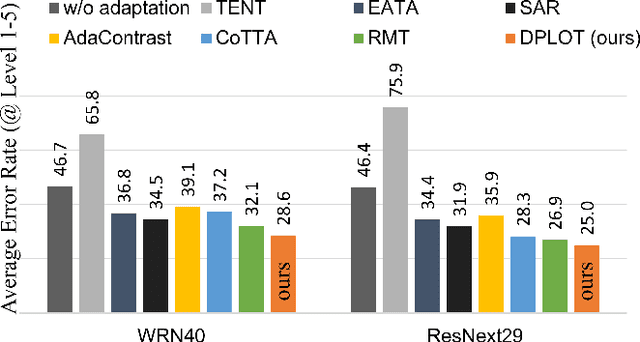
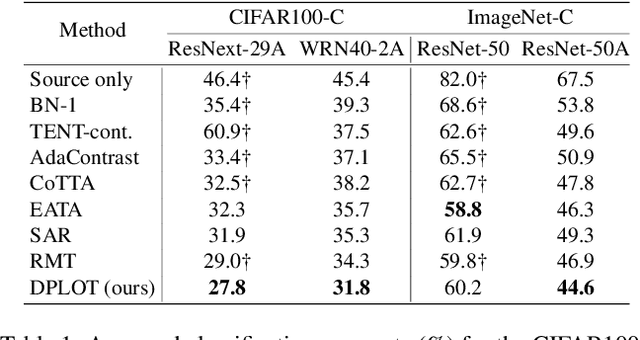
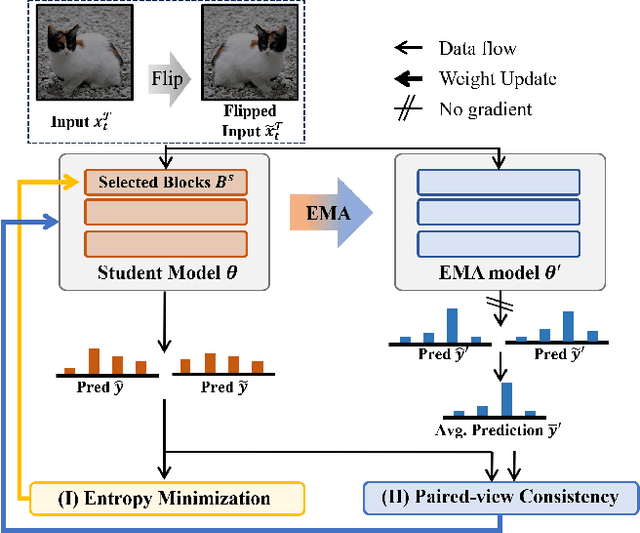
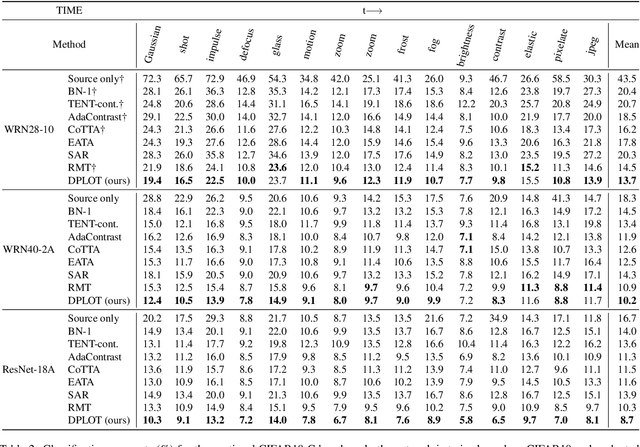
Abstract:Test-time adaptation (TTA) aims to adapt a pre-trained model to a new test domain without access to source data after deployment. Existing approaches typically rely on self-training with pseudo-labels since ground-truth cannot be obtained from test data. Although the quality of pseudo labels is important for stable and accurate long-term adaptation, it has not been previously addressed. In this work, we propose DPLOT, a simple yet effective TTA framework that consists of two components: (1) domain-specific block selection and (2) pseudo-label generation using paired-view images. Specifically, we select blocks that involve domain-specific feature extraction and train these blocks by entropy minimization. After blocks are adjusted for current test domain, we generate pseudo-labels by averaging given test images and corresponding flipped counterparts. By simply using flip augmentation, we prevent a decrease in the quality of the pseudo-labels, which can be caused by the domain gap resulting from strong augmentation. Our experimental results demonstrate that DPLOT outperforms previous TTA methods in CIFAR10-C, CIFAR100-C, and ImageNet-C benchmarks, reducing error by up to 5.4%, 9.1%, and 2.9%, respectively. Also, we provide an extensive analysis to demonstrate effectiveness of our framework. Code is available at https://github.com/gist-ailab/domain-specific-block-selection-and-paired-view-pseudo-labeling-for-online-TTA.
PolyFit: A Peg-in-hole Assembly Framework for Unseen Polygon Shapes via Sim-to-real Adaptation
Dec 05, 2023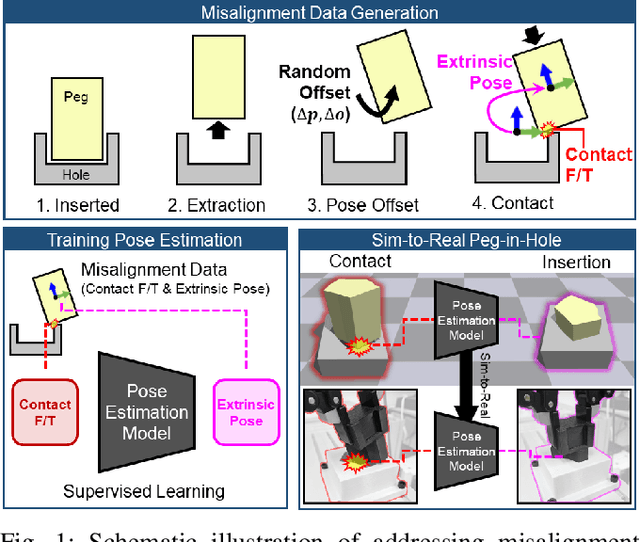
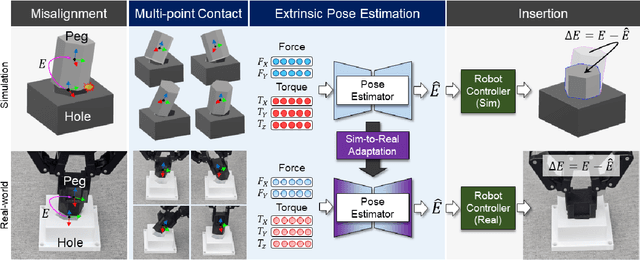
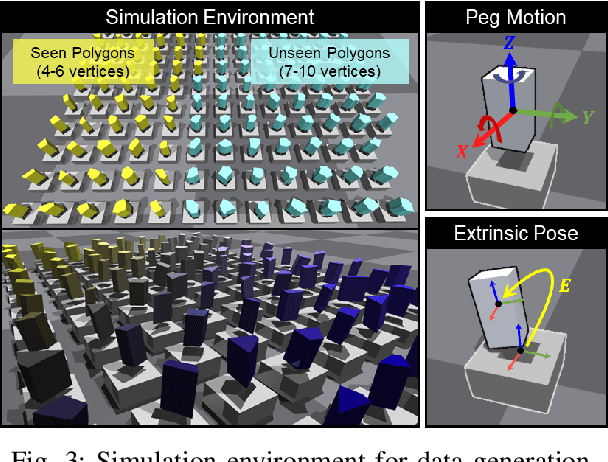
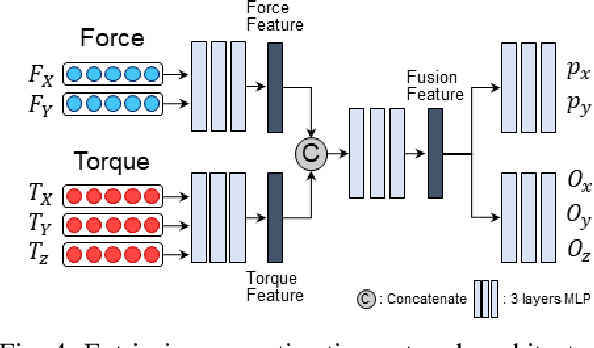
Abstract:The study addresses the foundational and challenging task of peg-in-hole assembly in robotics, where misalignments caused by sensor inaccuracies and mechanical errors often result in insertion failures or jamming. This research introduces PolyFit, representing a paradigm shift by transitioning from a reinforcement learning approach to a supervised learning methodology. PolyFit is a Force/Torque (F/T)-based supervised learning framework designed for 5-DoF peg-in-hole assembly. It utilizes F/T data for accurate extrinsic pose estimation and adjusts the peg pose to rectify misalignments. Extensive training in a simulated environment involves a dataset encompassing a diverse range of peg-hole shapes, extrinsic poses, and their corresponding contact F/T readings. To enhance extrinsic pose estimation, a multi-point contact strategy is integrated into the model input, recognizing that identical F/T readings can indicate different poses. The study proposes a sim-to-real adaptation method for real-world application, using a sim-real paired dataset to enable effective generalization to complex and unseen polygon shapes. PolyFit achieves impressive peg-in-hole success rates of 97.3% and 96.3% for seen and unseen shapes in simulations, respectively. Real-world evaluations further demonstrate substantial success rates of 86.7% and 85.0%, highlighting the robustness and adaptability of the proposed method.
INSTA-BEEER: Explicit Error Estimation and Refinement for Fast and Accurate Unseen Object Instance Segmentation
Jun 28, 2023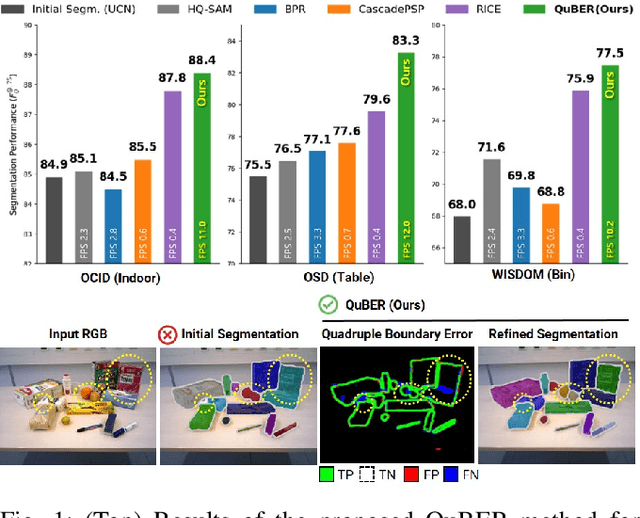
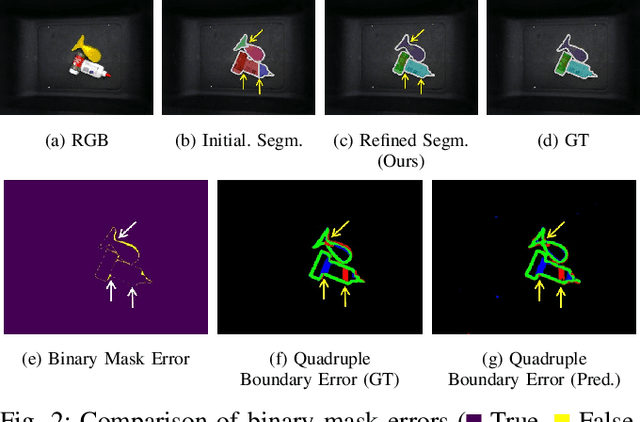
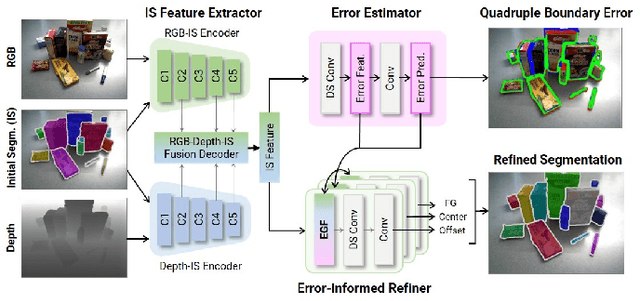

Abstract:Efficient and accurate segmentation of unseen objects is crucial for robotic manipulation. However, it remains challenging due to over- or under-segmentation. Although existing refinement methods can enhance the segmentation quality, they fix only minor boundary errors or are not sufficiently fast. In this work, we propose INSTAnce Boundary Explicit Error Estimation and Refinement (INSTA-BEEER), a novel refinement model that allows for adding and deleting instances and sharpening boundaries. Leveraging an error-estimation-then-refinement scheme, the model first estimates the pixel-wise boundary explicit errors: true positive, true negative, false positive, and false negative pixels of the instance boundary in the initial segmentation. It then refines the initial segmentation using these error estimates as guidance. Experiments show that the proposed model significantly enhances segmentation, achieving state-of-the-art performance. Furthermore, with a fast runtime (less than 0.1 s), the model consistently improves performance across various initial segmentation methods, making it highly suitable for practical robotic applications.
Learning to Place Unseen Objects Stably using a Large-scale Simulation
Mar 15, 2023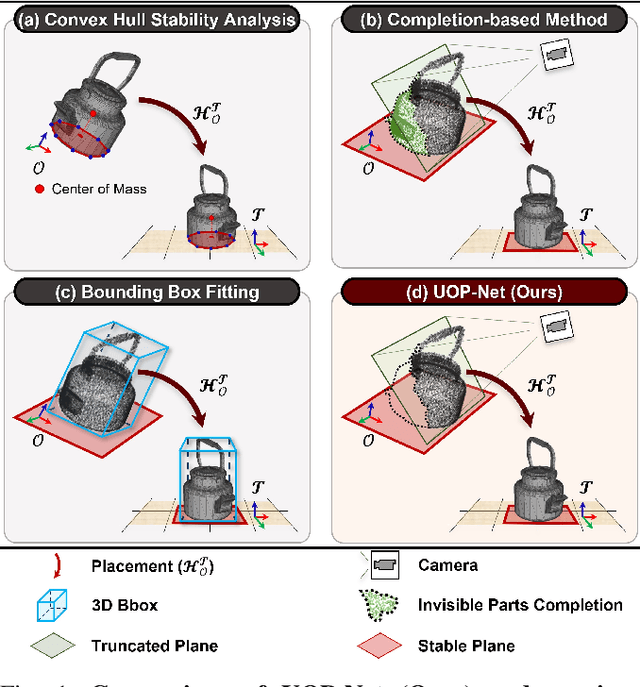
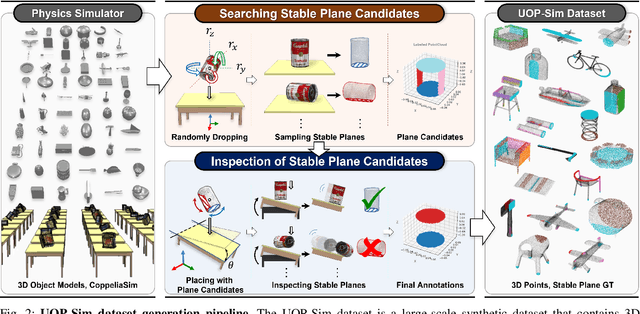
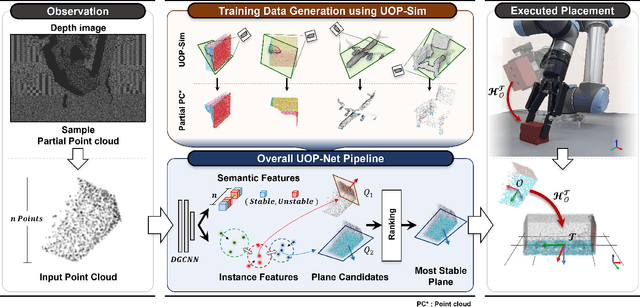
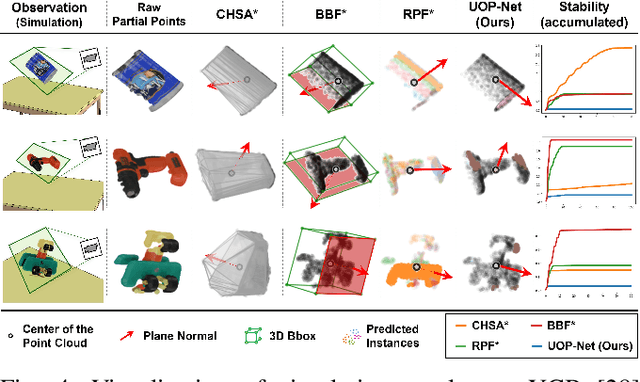
Abstract:Object placement is a crucial task for robots in unstructured environments as it enables them to manipulate and arrange objects safely and efficiently. However, existing methods for object placement have limitations, such as the requirement for a complete 3D model of the object or the inability to handle complex object shapes, which restrict the applicability of robots in unstructured scenarios. In this paper, we propose an Unseen Object Placement (UOP) method that directly detects stable planes of unseen objects from a single-view and partial point cloud. We trained our model on large-scale simulation data to generalize over relationships between the shape and properties of stable planes with a 3D point cloud. We verify our approach through simulation and real-world robot experiments, demonstrating state-of-the-art performance for placing single-view and partial objects. Our UOP approach enables robots to place objects stably, even when the object's shape and properties are not fully known, providing a promising solution for object placement in unstructured environments. Our research has potential applications in various domains such as manufacturing, logistics, and home automation. Additional results can be viewed on https://sites.google.com/uop-net, and we will release our code, dataset upon publication.
Enhancing Low-resolution Face Recognition with Feature Similarity Knowledge Distillation
Mar 08, 2023



Abstract:In this study, we introduce a feature knowledge distillation framework to improve low-resolution (LR) face recognition performance using knowledge obtained from high-resolution (HR) images. The proposed framework transfers informative features from an HR-trained network to an LR-trained network by reducing the distance between them. A cosine similarity measure was employed as a distance metric to effectively align the HR and LR features. This approach differs from conventional knowledge distillation frameworks, which use the L_p distance metrics and offer the advantage of converging well when reducing the distance between features of different resolutions. Our framework achieved a 3% improvement over the previous state-of-the-art method on the AgeDB-30 benchmark without bells and whistles, while maintaining a strong performance on HR images. The effectiveness of cosine similarity as a distance metric was validated through statistical analysis, making our approach a promising solution for real-world applications in which LR images are frequently encountered. The code and pretrained models will be publicly available on GitHub.
Block Selection Method for Using Feature Norm in Out-of-distribution Detection
Dec 10, 2022



Abstract:Detecting out-of-distribution (OOD) inputs during the inference stage is crucial for deploying neural networks in the real world. Previous methods commonly relied on the output of a network derived from the highly activated feature map. In this study, we first revealed that a norm of the feature map obtained from the other block than the last block can be a better indicator of OOD detection. Motivated by this, we propose a simple framework consisting of FeatureNorm: a norm of the feature map and NormRatio: a ratio of FeatureNorm for ID and OOD to measure the OOD detection performance of each block. In particular, to select the block that provides the largest difference between FeatureNorm of ID and FeatureNorm of OOD, we create Jigsaw puzzle images as pseudo OOD from ID training samples and calculate NormRatio, and the block with the largest value is selected. After the suitable block is selected, OOD detection with the FeatureNorm outperforms other OOD detection methods by reducing FPR95 by up to 52.77% on CIFAR10 benchmark and by up to 48.53% on ImageNet benchmark. We demonstrate that our framework can generalize to various architectures and the importance of block selection, which can improve previous OOD detection methods as well.
 Add to Chrome
Add to Chrome Add to Firefox
Add to Firefox Add to Edge
Add to Edge